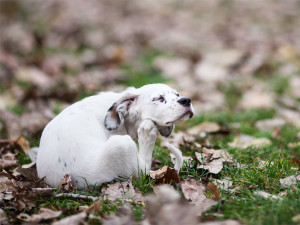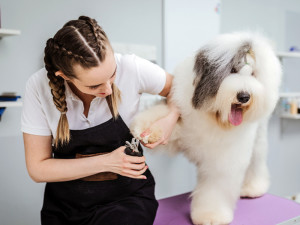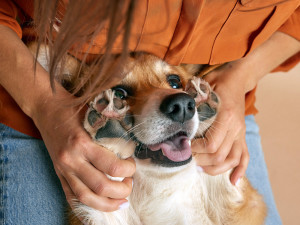Is It Snowing? Or Does Your Pet Have Dandruff?
Because Head & Shoulders is absolutely not for pet use, here‘s how to clear up that flaky, snowy skin of theirs
Dandruff. It ain’t cute, but it is a very common condition in people – just look at the hundreds of products aimed at fixing human dandruff on the shelves in Sainsbury’s and Boots. In fact, 50 percent of Brits are estimated to suffer from dandruffopens in new tab at some point in their lives. But, have you ever wondered if our pets have to deal with a similar issue? After all, they’ve certainly got a lot more hair than us.
Well, it’s true, pets can get dandruff too. So if you’ve noticed your kitty or pup looking a little flaky, that’s probably what you’re dealing with. In this article we look into what pet dandruff is, what the causes are and the things we can do at home to try to help our furry friends when the white flakes appear and they get all itchy. Most importantly, we’ll also consider when it‘s time to take your flaky friend to the vet.
What is pet dandruff?
Pet dandruff looks similar in appearance to the human version, small white flakes of dead skin within the fur or left on your pet’s bed. The veterinary terminology for it is ‘seborrhoea’ or ‘seborrheic dermatitis’, this is because it originates from either the overproduction or underproduction of something called ‘sebum’ in the skin. It can present as greasy, with yellowish oil or crusty plaques. The overproduction of sebum causes an imbalance within the skin barrier and leads to more flaky dead skin cells.
It is possible for pets to get dry skin and not have dandruff, especially as the seasons change, their skin can be more or less dry just like ours. And so it is important to know the signs to look out for that your pet‘s dry skin is more than a passing issue. As the skin is the largest organ of the body, once compromised the symptoms can be vast. Sometimes the symptoms are so mild you only notice some areas of dry skin when bathing or grooming your pet. If the dandruff is worse, you may notice white flakes on your pet‘s bed, it can even cause red and itchy skin leading your pet to scratch, which breaks down the skin barrier even further and poses a risk for secondary infections. Where the skin folds in on itself, such as the armpits, thighs, skin folds on face and in the ears, the extra surface area can create a warm, moist environment where yeast and bacteria can thrive. This causes a musty smell to the skin and oily flakes can be found on the skin. This can be quite unpleasant for your pet and is not nice for you to cuddle up to either! Keep reading to find out the best ways to prevent and treat this common problem.
There are other common conditions that look similar in symptoms to dandruff such as allergies and contact dermatitis, which is where your pet comes into contact with something irritating such as a plant or chemical. Skin cells normally flake off to some degree within their natural cycle, and so finding a few white flakes, particularly while grooming your pet, is no cause for concern, it’s when the number of flakes becomes excessive that there’s more going on under the surface.
Causes of pet dandruff
Dandruff can be a symptom of imbalances in the skin. Seborrhoea may be the term for the result but there are many things that can lead to the breakdown of the skin barrier and increase the risk of dandruff. Issues such as allergies and contact dermatitis can cause similar symptoms in the skin, and while this doesn’t always directly cause dandruff, the breakdown in the skin barrier can lead to excess skin shedding. And so, untreated issues that affect the skin can potentially cause further issues such as dandruff. Here are some common causes of the breakdown of the skin barrier:
Dry skin: long periods of having dry skin from weather changes or low humidity can breakdown the skin barrier over time.
Allergies: food and seasonal allergies affect the skin making it itchy and inflamed, this leads to scratching and a wear down of the barrier if left untreated.
Parasites: fleas, ticks and mites all love feasting on the skin, this mechanically breaks the skin barrier and also leads to scratching.
Infections: skin infections, called pyoderma, can cause damage to the skin and lead to excess sebum and oils on the skin as the body tries to protect itself.
Underlying health conditions: issues such as hypothyroidism, Addison‘s and Cushing’s all affect the skinopens in new tab due to internal hormonal balances leading to changes within the skin.
Diet: pets that are fed diets low in skin-strengthening ingredients such as omega fatty acids and vitamins lack the necessary components to help keep the skin healthy.
As British people, we love to complain about the weather and for our furry friends it can cause as much bother to themopens in new tab as it does to us. Here in the UK our weather is constantly changing; even in summer there can be warm, wet weather that causes skin issuesopens in new tab, especially in the long haired breeds that trap the warmth and moisture.
Identifying dandruff in pets
The best way to identify dandruff is with a visual inspection of your pet’s coat. This can be done while you are grooming or bathing your pet or even while cuddling up together watching TV. Using your fingers, part their fur in various places over their body to make sure you check all the way down to their skin.
The most common areas for dandruff to appear are along their back, armpits and stomach. What you are looking for is an excess of small white flakes of skin that look similar to human dandruff. Finding a few is normal and nothing to worry about, especially if you are grooming as this helps exfoliate the dead skin making it look like there’s more than normal. When there is an overproduction of sebum and oil, it may feel like the skin is greasy to the touch, and the dandruff can form little clumps around the base of the fur rather than falling off. In these cases it can collect other dust and so can appear darker in colour or even slightly yellow.
Additional symptoms to look for if you’ve found a patch of dandruff is that your pet may get itchy and as you are stroking or grooming the area they may start their back legs as they feel the need to scratch. In areas where the dandruff is causing an issue the skin may appear red and warm to the touch, sometimes thickened and scaly, and sometimes gives off a smell.
Are certain breeds more prone to dandruff?
All pets can get dandruff. In particular, birds produce a lot of dander – mainly from their pin feather sheaths they pull off as they preen, this is completely normal for birds! Dogs are probably the second biggest dandruff makers, while cats are the runners up. It may be in part that cats are fastidious cleaners and so by grooming themselves constantly they keep the dandruff to a minimum. This means however, if you do spot your feline friend creating more dandruff than normal it would be a good idea to try to inspect their skin and if any other symptoms are noted, speak to your vet about possible causes for excess dandruff or the reasons why they may not be grooming themselves as much.
While all dogs have the potential to have dandruff, there are some that are more predisposed to the condition either due to their genetics or because they have medium to long fur. The main breeds that I see with dandruff as a vet in Scotland are:
West Highland Terriers
Golden Retrievers
Shar Peis
Yorkshire Terriers
German Shepherds
French Bulldogs
Labradors
If you don’t see your pet on the list, it’s important to still be on the lookout as dandruff can affect any breed if the conditions are right. Some contributing factors include age and underlying health conditions. As our pets get older, the skin becomes less elastic and regenerates more slowly, just the same as in humans. This means that the skin barrier has the potential to break down more easily in senior pets than in younger animals.
If your pet is older, it is also more likely that your pet has underlying conditions or hormonal imbalances which can affect the skin, in particular conditions such as hypothyroidism, Addison‘s and Cushing‘s which can affect the skin and fur health. Make sure your pet has regular health check-ups to ensure these health conditions are being found and treated, sometimes a build up of dandruff can even alert you to the onset of these problems.
Other conditions such as allergies can harm the skin barrier from the inside and also cause our furry friends scratch at the itch which can mechanically break the skin and not only pull away more skin cells than necessary but also put them at a higher risk of secondary yeast or bacterial skin infections, leading to yet more dandruff.
Health implications of dandruff
Throughout this article, the main concern that dandruff may be connected to are secondary infections, but what do we mean by that? A secondary infection is when naturally occurring bacteria or yeast that live on the skin take advantage of a breakdown in the balance within the skin from things such as a change in pH, injury or change in structure to the skin barrier from internal conditions. These yeast or bacteria pathogens that thrive in these changed conditions overpower the normal defences of the skin, leading to infection. Not only do they need to be treated, but the underlying reason for the change needs to be found and treated in order to prevent the secondary infection from repeating.
Signs that a secondary infection may have taken hold are:
Smell from the skin: usually when a yeast called ‘malassezia’ takes hold and the skin develops a musty/yeasty smell.
Pus: this is a sign of a bacterial infection within the skin.
Hot spots: also known as ‘wet eczema’, show as patches of raw skin with clear or yellow discharge commonly found on long haired dogs.
Ear infections: skin in the ear can be easily affected and due to the warmth and surface area can get infected quickly.
Excessive scratching: nibbling at paws and scratching over and over until red raw and even breaking the skin.
These are all signs that your pet needs to be seen by a vet, for a physical examination and treatment for both the infection and to investigate the cause of the original problem of the itchiness and dandruff. If left untreated, these infections can spread to all over the body and also down into the skin causing a deep pyoderma which can cause more pain, ulceration and require more extensive treatment.
Other signs you may notice first before the secondary infection takes root are a greasy coat (even after a bath or two), hair loss, and one stranger reaction to look out is your pet having random zoomies whilst scuffing their feet as the allergy is causing itchiness that they don’t know how to scratch in their paws. Do note however, zoomies are perfectly normal most of the time. If you have any concerns, try to video their behaviour as this can be very helpful to vets to differentiate between causes.
Treatment and management options for pet dandruff
So, we now know some of the reasons that our pets get excess dandruff, but what can we do as owners at home to help? As losing dead skin cells is completely normal we must first make sure we know what is normal for our pet, this means knowing your furry friend’s skin. The best way to understand what is normal for our pets is to incorporate a routine of grooming (or at least inspection) at least once a week to know how their skin is reacting to the fluctuations in temperature and humidity. Once we know what ‘normal’ is we can look out for changes in skin tone and flakiness.
When we treat dandruff we need to start with what is causing the condition, if their skin is too dry we need to add moisture – using a humidifier can sometimes help. Bathing can be useful too, however too much or too little can cause an imbalance in the sebum amount on the skin, as we don’t want to wash away the healthy oils completely. There is a fine balance and you may need a bit of trial and error to find what is best for your pet. A good rule of thumb is: no more than bathing 2-3 times a week when their skin is bad and needs treatment, and a bath is really only needed once every few weeks if they have good skin. We need to allow time for sebum production to rebalance and the barrier to heal.
Grooming can be a useful tool to exfoliate the skin and get rid of excess dander. This can be really satisfying to both you and your pet, and makes for a great bonding session. Puppies and kittens get groomed by their mothers and so naturally it feels good to them. Grooming can stimulate blood flow to the skin, helping create healthy skin and it can also move the oil through the fur to help get that glossy coat. If you notice an excess of dandruff there are some topical treatments that can help at home:
Shampoo: stick to gentle moisturising cleansers designed for pets, particularly those with antifungal properties.
Mousse: some brands offer a mousse-based product which is easier for those pets that hate bath-time
Wipes: quick and easy to use, antifungal/antibacterial wipes designed for pets can help with smaller areas.
If you find bathing or grooming your pet difficult or you are unsure how, check out this guide from the Blue Crossopens in new tab, or consider taking your pet to a groomer. Having a professional groom and bath your pet can be very helpful, they are very knowledgeable about your pets anatomy and can tackle any matted or problem areas safely and pain-free. Groomers are also another pair of eyes to help spot anything ‘off’ about your pet’s skin. The cost of going to the groomers varies across the UK with an average cost of £43opens in new tab but ranges from £20-£90+ so have a look around your local area to find one that suits you and your pet, and yes there are grooming establishments that take cats!
When you have a pet with skin sensitivities your local vet will be able to provide you with investigative routes to find the cause and provide treatment options. If your furry friend has a particularly bad issue or it is complicated by other underlying health conditions your vet may refer them to a dermatology specialist. These are vets that have a speciality in all things skin related and can be found all over the UK. Explore your options and see if there’s a dermatology specialist at your local hospital, ask your vet where they usually refer patients to nearby.
While there are a lot of products on the shelves dedicated to helping itchy dogs and help create healthy skin, do look into the ingredients and make sure it is safe for your pet. Some pets are sensitive to certain ingredients just like us, and so a patch test on a small area first may be useful. More potent treatment has to come from the vet and some is prescription only, these treatments include specific medicated shampoos, tablets such as Apoquel, injections like Cytopoint or immune therapy and steroid-based medication. And of course, antibiotic use for any secondary infections must be prescribed by a vet after a physical examination to determine the best course of action.
Preventing pet dandruff
As always, prevention is better than treatment so here are a few ways you can prevent excess dandruff.
Establish a grooming routine. For short, smooth coated breeds try to brush at least once a week and others with longer or easily matted fur may need brushing more often.
Getting their fur clipped can help to keep the skin from becoming too warm and moist, especially in the warmer months. As yeast thrive in dark, damp and warm areas, getting good airflow down to the skin is very important, always dry your pet thoroughly after they swim or have a bath, and watch out for areas they lick often as this creates the same problem.
Use of an antifungal shampoo or wipe as soon as you spot a change in fur colour to the orange/pink from overactive licking may also prevent problems escalating.
To help keep the skin cool in the summer months, having long haired breeds clipped or regularly brushed can keep things more comfortable. Otherwise, or offering the use of cooling mats. In the Winter months when the air becomes cold and harsh on the skin try using more moisturising pet products to help protect the skin barrier.
Diet is an important factor when it comes to skin health, the skin is made up of water, proteins, lipids and minerals. So it is important your pet has a well rounded nutritional diet that incorporates all of these properties to ensure the skin has all the components it needs to remain strong and healthy. In particular, ingredients such as omega fatty acids and vitamin E can help support the skin’s function. Make sure you are careful to not use ingredients your dog or cat is sensitive too, dogs commonly have allergies to some protein sources. Top contenders for dog food allergies are beef, chicken and pork, and so if your pup is showing signs of itchiness and skin problems when fed these ingredients talk to your vet about a food trial to ensure there are no hidden sensitivities.
Common myths and misconceptions
The only way to get rid of dandruff is to bath your pet constantly
While it’s true some bathing can help add moisture to your pet’s skin and the use of moisturising and antifungal/antibacterial shampoos may help secondary infections, overbathing can be just as harmful as underbathing. Stripping away the natural oils constantly can lead to an imbalance within the skin barrier.
If any dandruff is visible, there’s a skin problem
Skin cells naturally go through a cycle and are shed at the end. It is perfectly normal to see some flaky skin especially while grooming as this exfoliates the skin and allows dead cells to be brushed away.
The only way to get a dog to stop scratching is to tell them off
Your pet will always want to please you and will sometimes stop scratching when you ask, but it doesn’t stop the source of the itch. And being itchy and not able to scratch can be very frustrating to your pet, so much so that their behaviour can change as they become more irritated. Instead, try to see their scratching as a symptom of a problem rather than the problem itself and try to find out the source. Contact your vet for further investigations and for possible treatment to stop the itch if needed.
Frequently asked questions about pet dandruff
My dog keeps getting ear infections. Why has my vet diagnosed skin issues?
As the skin continues into the ears anything that affects the skin can affect the ears, particularly as there is a lot of surface area in the fold of the ear canal and the dark moist environment allows secondary infection to take hold quickly. Sometimes, ear infections are a symptom of a wider problem with the skin.
Why does my pet’s skin issue keep coming back after it was treated?
While there are many treatment options for skin issues, it should really be thought of as skin management. Skin issues can be very frustrating to deal with as a pet owner as it goes in cycles and just when you feel you have got on top of the problem, the season changes or another itchy episode is triggered and it feels like you’re back where you started. Work together with your vet to create a management plan for these flare ups if you have a skin sensitive animal.
Conclusion
In summary, dandruff in pets is seen all across the UK, and the causes of dandruff are plentiful. Try to look at excess flaky skin as a symptom to a problem rather than the issue itself and work together with your vet to investigate the issue’s primary source and the best way to remove dandruff.
Remember, there is a higher risk of dandruff with some breeds and at certain ages, along with dietary and environmental causes such as changes in weather and low humidity. If you notice your pet scratching more than normal or they are experiencing repeat ear infections, make an appointment with your vet to look into allergies or hypersensitivities that may be making dandruff worse.
Overall, skin issues can be a frustrating issue for pets and their owners, however there are many options available for long term management, so work together with your vet, groomer and family at home to establish a skin care routine that’s best for you and your pet to minimise the impact of itchy and flaky skin through appropriate grooming, diet and bathing when necessary.
References
Dermatologic manifestations of endocrine disordersopens in new tab
How to groom a dogopens in new tab
Summer skin care for dogs and catsopens in new tab














